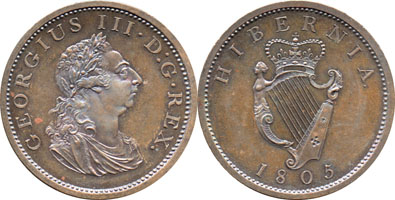Reflectivity
The angle made by the light of a scanner to the item being scanned is relatively fixed, while objects
and light sources photographed by cameras can be varied to best effect. This can be seen by images of
an 1805 Irish penny graded Proof-64 by PCGS. The upper image captured by the scanner shows a high amount
of detail, but the surface is a matte brown and no reflectivity is seen. The lower image is captured by
the camera and the mirror quality of the surface is clear.
|


|
| | |
Luster
Related to reflectivity is luster. Mint state coins often show a cartwheel effect produced by microscopic
flow lines on the coin's surface, such as seen on this 1881-S PCGS MS66 Morgan dollar. As before, the scanner
sees the high detail of the coin, but also as before, the coin exhibits a matte surface. Highlights
are seen in the hair, however, as the scanner light has reached it at an advantageous angle. In contrast,
the camera sees a significant cartwheel on the coin's surface and the coin itself has a more even
appearance with the hair no more highlighted than the rest of the coin.
|
 
|
| | |
Toning
Scanners may also not see toning of a coin correctly. The 1881-S Morgan shows this slightly - the pink toning in PLURIBUS
appears as almost a shadow in the scan - but this PCGS MS64 1904-O Morgan dollar shows it dramatically.
The coin in hand appears as the camera sees it - an obverse of lustrous purple and green. The scanner sees
a completely different matte orange and green. Although radically different, it is clear that it is the
same coin - note the white irregular feature below and to the left of the ear along the cheek and neck -
it is seen in both images.
|
 
|













